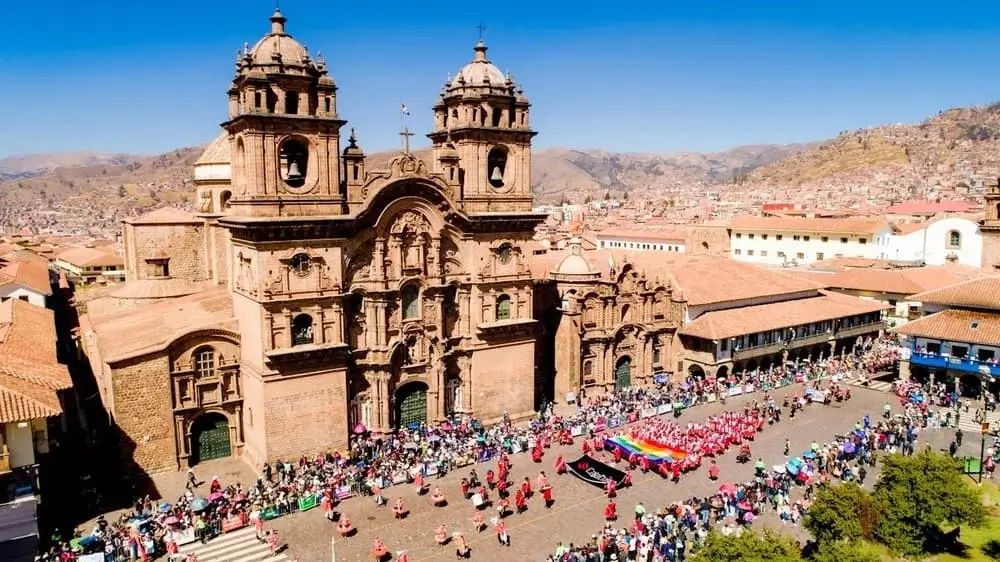Discover One of Peru’s Most Majestic Landmarks in the Heart of the Ancient Inca Capital
Perched at the center of Cusco’s vibrant Main Square, the Cathedral Basilica of the Assumption of the Virgin better known as the Cusco Cathedral is far more than a place of worship. It's a masterpiece of colonial architecture, a repository of Andean history, and a symbolic bridge between Inca tradition and Spanish legacy.
Whether you're a passionate art lover, a history enthusiast, or a family exploring the wonders of Peru, this monumental structure invites awe with every detail from its richly adorned altars and golden treasures to its captivating legends. Read on to explore the fascinating story, design, and significance of this UNESCO World Heritage jewel and learn how to make the most of your visit.
Quick Facts About Cusco Cathedral
- Official Name: Cathedral Basilica of the Assumption of the Virgin
- Location: Plaza de Armas, Historic Center of Cusco
- Construction Period: 1559 – 1654
- Architectural Style: Gothic-Renaissance with Baroque details
- UNESCO Designation: Part of the “City of Cusco” World Heritage Site (1983)
- Significance: Cultural, religious, and artistic symbol of colonial Peru
History of Cusco Cathedral: From Inca Palace to Colonial Glory
Before the cathedral rose to prominence, the site was home to the palace of Inca Wiracocha, a sacred place in the heart of the Inca Empire. Following the Spanish conquest, the location was transformed into a symbol of colonial dominance. Construction began in 1559 and spanned almost a century, incorporating stones from the nearby Sacsayhuamán fortress.
The structure that emerged is a blend of European architecture and Andean artistry, a true fusion that reflects the city’s complex cultural transformation during the Spanish era.
Take a look at our Cusco Tours. you may also be wondering why does Cusco have a rainbow flag read our blog to find out
Architectural Marvel: A Fusion of Styles and Spirituality
The cathedral boasts a commanding façade of carved stone, flanked by two robust towers. Inside, the structure is divided into three naves, supported by 14 massive pillars and filled with chapels, altars, and religious artwork. The styles range from Gothic-Renaissance to Baroque, with Andean influences subtly integrated.
🔹 Main Altar and Silver Masterpieces
One of its most remarkable features is the main altar, crafted from over 1,250 kilograms of silver, making it one of the most valuable colonial silverworks in the Americas. Intricate wood carvings and gold-leaf ornamentation add splendor to the chapels.
🔹 Cuzco School Paintings
Art lovers will be captivated by over 400 paintings from the Cuzco School of Art, including a reinterpretation of The Last Supper, where traditional Andean dishes like cuy (guinea pig) are served to Jesus and his disciples.
🔹 The Lord of the Earthquakes
The Señor de los Temblores (Christ of the Earthquakes) is a deeply venerated figure in Cusco. According to local legend, this crucified Christ image protected the city during the devastating earthquake of 1650, cementing its role in Cusco's spiritual identity.
- Travel Tip: Visit during Holy Week to witness the dramatic procession of the Señor de los Temblores.
Artistic & Cultural Significance: Layers of Symbolism
Cusco Cathedral is more than just beautiful it’s a narrative carved in stone and painted in symbolism. Each painting, sculpture, and detail reflects not only Christian ideology but also syncretic expressions of indigenous beliefs. Look closely, and you’ll notice Andean iconography, local flora and fauna, and hidden messages that reflect the merging of two worlds.
Did you know? Many colonial artworks in the cathedral depict saints with Andean features and traditional Peruvian clothing.
How to Visit the Cathedral of Cusco
Location:
Right in the Plaza de Armas, Cusco’s central square—walking distance from most hotels, museums, and restaurants.
Hours & Entrance:
Opening Hours: Monday to Sunday, 10:00 a.m. to 6:00 p.m.
Entrance Fee: Tickets can be purchased individually or as part of the Religious Circuit (which also includes Church of the Society of Jesus and San Blas Temple).
Book your Religious Circuit tour with us.
Tours & Guides:
We recommend taking a guided tour to uncover the hidden symbols, historical anecdotes, and artistic secrets of the cathedral.
Pro Travel Tips for Your Visit
- Go Early: Beat the crowds and experience the serenity of the cathedral in the morning light.
- Dress Respectfully: It’s an active place of worship cover shoulders and avoid loud behavior.
- Look Up: The ceiling frescoes and dome paintings are often overlooked but incredibly detailed.
- Bring a Guidebook or Hire a Local Expert: You’ll appreciate the symbolism and artwork so much more.
A visit to the Cathedral of Cusco is an unforgettable journey into the soul of Peru. Its artistic mastery, layered history, and religious power make it an essential experience for anyone exploring the Sacred Valley, Machu Picchu, or the Andean Highlands.
Whether you're drawn to its silver-covered altars, intrigued by stories of saints and earthquakes, or captivated by the interplay of cultures, the Cathedral of Cusco offers something profoundly moving for every traveler.

